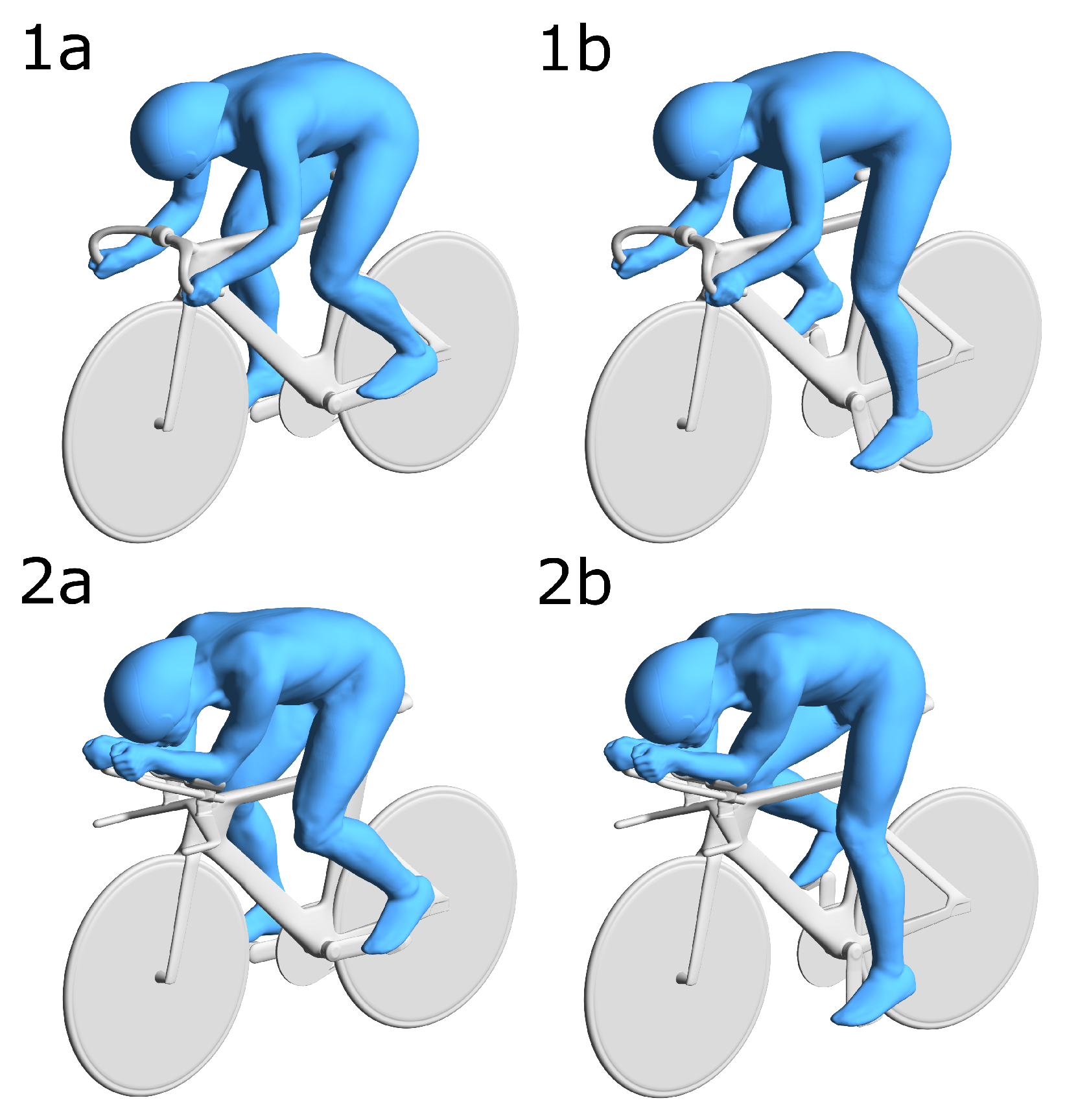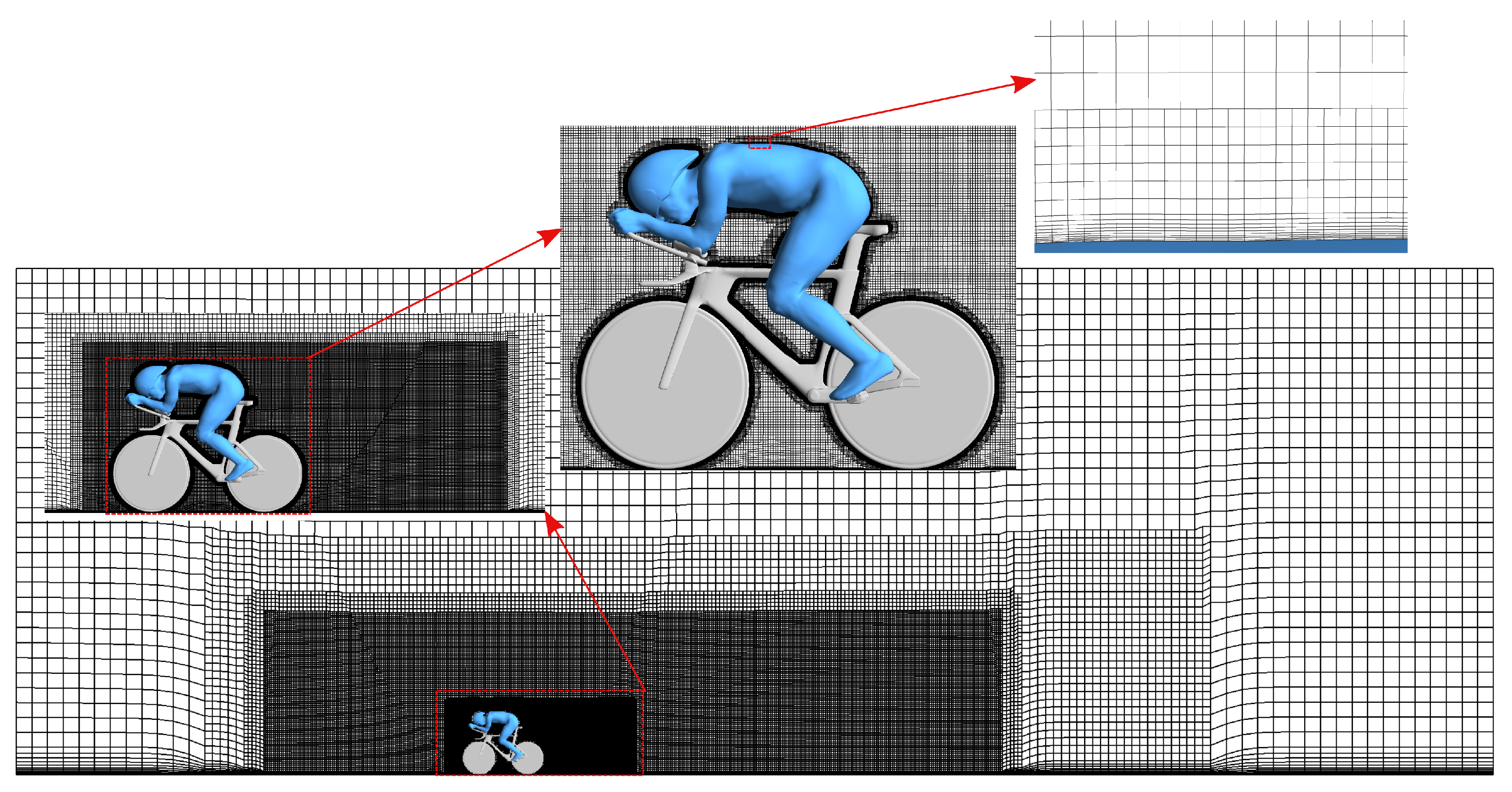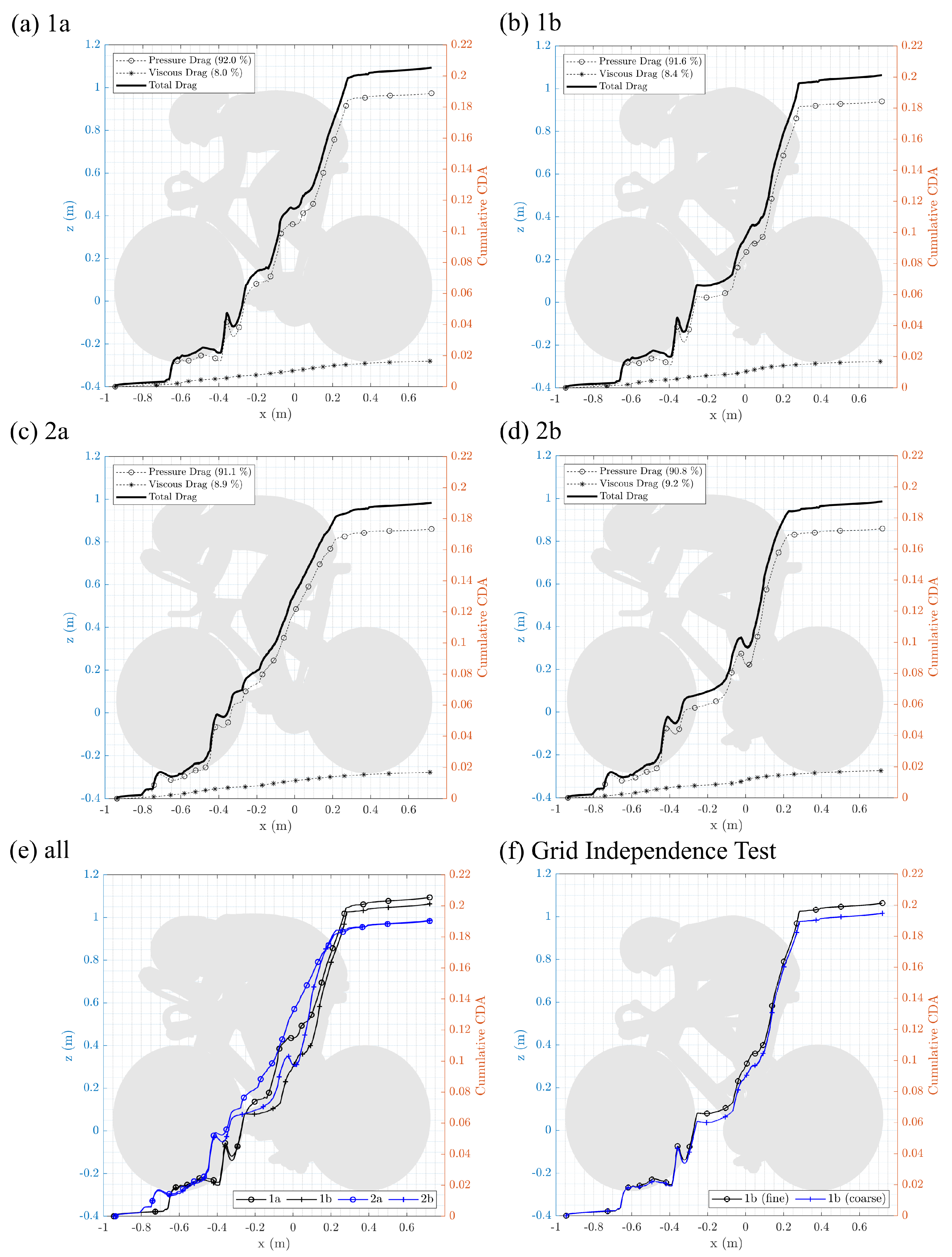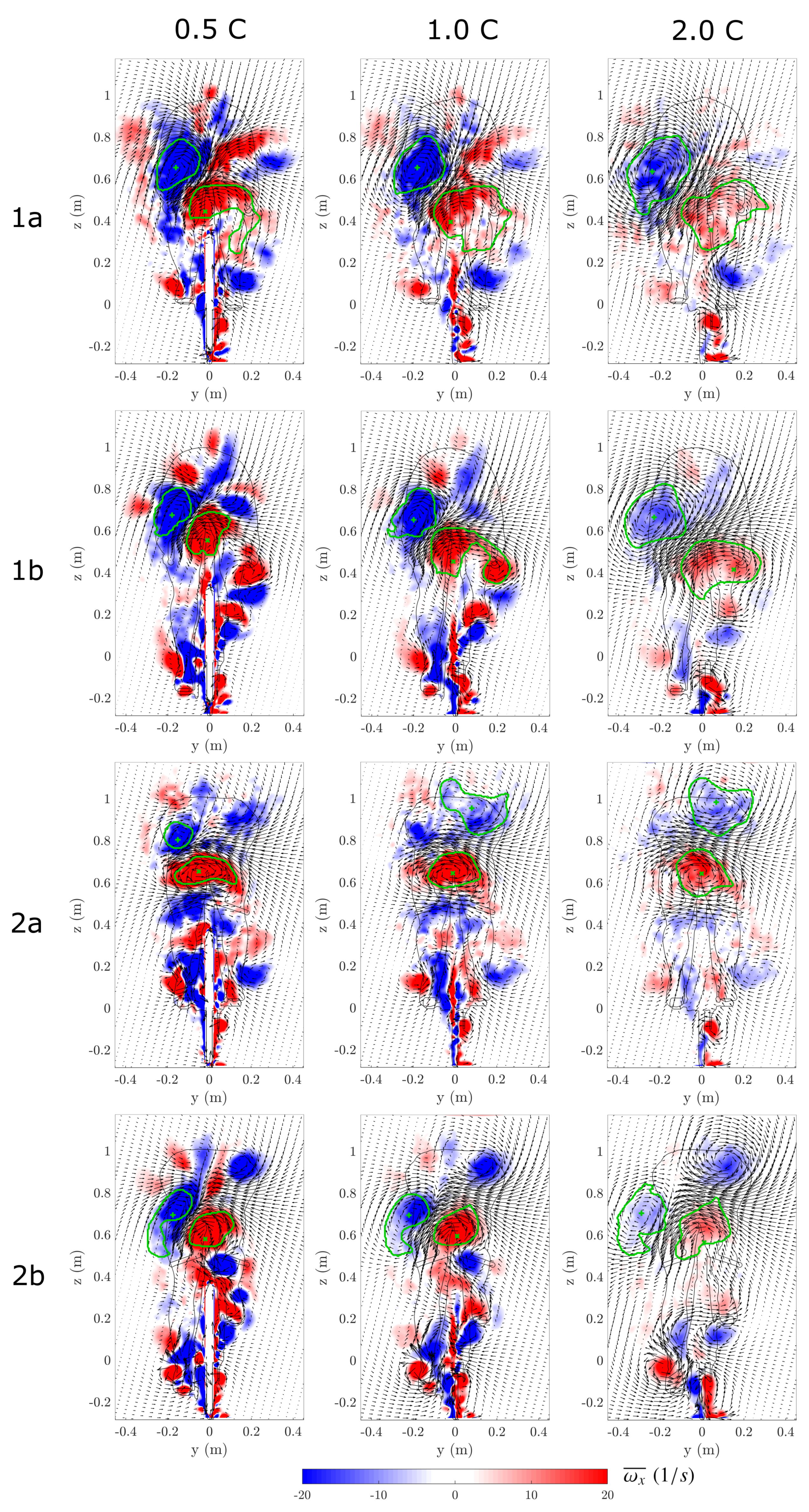The Influence of the Inter-Relationship of Leg Position and Riding Posture on Cycling Aerodynamics
Abstract
:1. Introduction
2. Methodology
2.1. Geometry and Boundary Conditions
2.2. Meshing Strategy
2.3. Mathematical Model and Solver Description
2.4. Validation
3. Results and Analysis
3.1. Aerodynamic Loading
3.2. Dominant Wake Flow Structures
3.3. Wake Propagation
3.4. Wake Dynamics
4. Conclusions
Author Contributions
Funding
Institutional Review Board Statement
Informed Consent Statement
Data Availability Statement
Conflicts of Interest
References
- Kyle, C.; Weaver, M. Aerodynamics of human-powered vehicles. Proc. Inst. Mech. Eng. Part A J. Power Energy 2004, 218, 141–154. [Google Scholar] [CrossRef]
- Crouch, T.; Thompson, M.; Burton, D.; Sheridan, J.; Brown, N. Dominant flow structures in the wake of a cyclist. In Proceedings of the 30th AIAA Applied Aerodynamics Conference, New Orleans, LA, USA, 25–28 June 2012; p. 3212. [Google Scholar]
- Crouch, T.N.; Burton, D.; Brown, N.A.T.; Thompson, M.C.; Sheridan, J. Flow topology in the wake of a cyclist and its effect on aerodynamic drag. J. Fluid Mech. 2014, 748, 5–35. [Google Scholar] [CrossRef]
- Griffith, M.D.; Crouch, T.; Thompson, M.C.; Burton, D.; Sheridan, J.; Brown, N.A. Computational fluid dynamics study of the effect of leg position on cyclist aerodynamic drag. J. Fluids Eng. 2014, 136, 101105. [Google Scholar] [CrossRef] [Green Version]
- Mannion, P.; Toparlar, Y.; Blocken, B.; Clifford, E.; Andrianne, T.; Hajdukiewicz, M. Aerodynamic drag in competitive tandem para-cycling: Road race versus time-trial positions. J. Wind Eng. Ind. Aerodyn. 2018, 179, 92–101. [Google Scholar] [CrossRef]
- Blocken, B.; Toparlar, Y.; van Druenen, T.; Andrianne, T. Aerodynamic drag in cycling team time trials. J. Wind Eng. Ind. Aerodyn. 2018, 182, 128–145. [Google Scholar] [CrossRef]
- Blocken, B.; van Druenen, T.; Toparlar, Y.; Malizia, F.; Mannion, P.; Andrianne, T.; Marchal, T.; Maas, G.J.; Diepens, J. Aerodynamic drag in cycling pelotons: New insights by CFD simulation and wind tunnel testing. J. Wind Eng. Ind. Aerodyn. 2018, 179, 319–337. [Google Scholar] [CrossRef]
- Barry, N.; Burton, D.; Sheridan, J.; Thompson, M.; Brown, N.A. Aerodynamic performance and riding posture in road cycling and triathlon. Proc. Inst. Mech. Eng. Part P J. Sport. Eng. Technol. 2015, 229, 28–38. [Google Scholar] [CrossRef]
- Blocken, B.; van Druenen, T.; Toparlar, Y.; Andrianne, T. CFD analysis of an exceptional cyclist sprint position. Sport. Eng. 2019, 22, 10. [Google Scholar] [CrossRef] [Green Version]
- Crouch, T.; Menaspà, P.; Barry, N.; Brown, N.; Thompson, M.C.; Burton, D. A wind-tunnel case study: Increasing road cycling velocity by adopting an aerodynamically improved sprint position. Proc. Inst. Mech. Eng. Part J. Sport. Eng. Technol. 2019, 235. [Google Scholar] [CrossRef]
- Fintelman, D.; Sterling, M.; Hemida, H.; Li, F.X. The effect of crosswinds on cyclists: An experimental study. Procedia Eng. 2014, 72, 720–725. [Google Scholar] [CrossRef]
- Jeukendrup, A.E.; Martin, J. Improving cycling performance. Sport. Med. 2001, 31, 559–569. [Google Scholar] [CrossRef]
- Defraeye, T.; Blocken, B.; Koninckx, E.; Hespel, P.; Carmeliet, J. Aerodynamic study of different cyclist positions: CFD analysis and full-scale wind-tunnel tests. J. Biomech. 2010, 43, 1262–1268. [Google Scholar] [CrossRef] [Green Version]
- Griffith, M.D.; Crouch, T.N.; Burton, D.; Sheridan, J.; Brown, N.A.; Thompson, M.C. A numerical model for the time-dependent wake of a pedalling cyclist. Proc. Inst. Mech. Eng. Part P J. Sport. Eng. Technol. 2019, 233, 514–525. [Google Scholar] [CrossRef]
- García-López, J.; Rodríguez-Marroyo, J.A.; Juneau, C.E.; Peleteiro, J.; Martínez, A.C.; Villa, J.G. Reference values and improvement of aerodynamic drag in professional cyclists. J. Sport. Sci. 2008, 26, 277–286. [Google Scholar] [CrossRef]
- Underwood, L.; Schumacher, J.; Burette-Pommay, J.; Jermy, M. Aerodynamic drag and biomechanical power of a track cyclist as a function of shoulder and torso angles. Sport. Eng. 2011, 14, 147–154. [Google Scholar] [CrossRef]
- Barry, N.; Burton, D.; Sheridan, J.; Thompson, M.; Brown, N.A. Aerodynamic drag interactions between cyclists in a team pursuit. Sport. Eng. 2015, 18, 93–103. [Google Scholar] [CrossRef]
- Ansys, A.F. 14.0 Theory Guide; ANSYS Inc.: Canonsburg, PA, USA, 2011; Volume 390, p. 732. [Google Scholar]
- Menter, F.R.; Kuntz, M.; Langtry, R. Ten years of industrial experience with the SST turbulence model. Turbul. Heat Mass Transf. 2003, 4, 625–632. [Google Scholar]
- Wang, S.; Bell, J.R.; Burton, D.; Herbst, A.H.; Sheridan, J.; Thompson, M.C. The performance of different turbulence models (URANS, SAS and DES) for predicting high-speed train slipstream. J. Wind Eng. Ind. Aerodyn. 2017, 165, 46–57. [Google Scholar] [CrossRef]
- Shur, M.L.; Spalart, P.R.; Strelets, M.K.; Travin, A.K. A hybrid RANS-LES approach with delayed-DES and wall-modelled LES capabilities. Int. J. Heat Fluid Flow 2008, 29, 1638–1649. [Google Scholar] [CrossRef]
- Gritskevich, M.S.; Garbaruk, A.V.; Schütze, J.; Menter, F.R. Development of DDES and IDDES formulations for the k-ω shear stress transport model. Flow, Turbul. Combust. 2012, 88, 431–449. [Google Scholar] [CrossRef]
- Saini, R.; Karimi, N.; Duan, L.; Sadiki, A.; Mehdizadeh, A. Effects of near wall modeling in the improved-delayed-detached-eddy-simulation (IDDES) methodology. Entropy 2018, 20, 771. [Google Scholar] [CrossRef] [PubMed] [Green Version]
- Graftieaux, L.; Michard, M.; Grosjean, N. Combining PIV, POD and vortex identification algorithms for the study of unsteady turbulent swirling flows. Meas. Sci. Technol. 2001, 12, 1422. [Google Scholar] [CrossRef]
- Sirovich, L. Turbulence and the dynamics of coherent structures. I. Coherent structures. Q. Appl. Math. 1987, 45, 561–571. [Google Scholar] [CrossRef] [Green Version]
- Wang, S.; Avadiar, T.; Thompson, M.C.; Burton, D. Effect of moving ground on the aerodynamics of a generic automotive model: The DrivAer-Estate. J. Wind Eng. Ind. Aerodyn. 2019, 195, 104000. [Google Scholar] [CrossRef]










| Case | Frontal Area (m) | Leg Position | Method | (m) | |
|---|---|---|---|---|---|
| Sprint | [9] | 0.37 | horizontal | CFD | 0.236 |
| [5] | 0.3979 | horizontal | CFD | 0.233 | |
| [11] | NA | horizontal | WT | 0.3 | |
| [8] | 0.4594 | dynamics | WT | 0.306 | |
| [12] | NA | dynamics | WT | 0.307 | |
| [13] | NA | horizontal | WT | 0.243 | |
| Pursuit | [5] | 0.3935 | horizontal | CFD | 0.213 |
| [4] | NA | horizontal | CFD | 0.201 (from plots) | |
| [4] | NA | vertical | CFD | 0.166 (from plots) | |
| [14] | NA | horizontal (dynamics) | CFD | 0.15 (from plots) | |
| [14] | NA | vertical (dynamics) | CFD | 0.19 (from plots) | |
| [8] | 0.3855 | dynamics | WT | 0.283 | |
| [12] | NA | dynamics | WT | 0.259 | |
| [15] | NA | horizontal | WT | 0.26 | |
| [16] | NA | dynamics | WT | 0.26∼0.296 | |
| [13] | NA | horizontal | WT | 0.211 | |
| [17] | NA | dynamics | WT | 0.214∼0.251 |
| Boundary Locations | Boundary Types | Expressions of Constraints |
|---|---|---|
| Inlet | Velocity inlet | |
| Outlet | Pressure outlet | |
| Top and Sides | Symmetry | |
| Ground | Moving wall (translation) | |
| Rider and bike frame | Stationary wall | |
| Bike wheels and tyres | Moving wall (rotation) |
| 1a | 1b | 1b (Coarse) | 2a | 2b | ||
|---|---|---|---|---|---|---|
| Frontal Area (m) | 0.367 | 0.370 | 0.370 | 0.352 | 0.351 | |
| mean | 0.205 | 0.201 | 0.195 | 0.190 | 0.191 | |
| std | 0.006 | 0.004 | 0.004 | 0.004 | 0.003 | |
| mean | 0.560 | 0.544 | 0.527 | 0.540 | 0.543 | |
| std | 0.015 | 0.011 | 0.011 | 0.011 | 0.009 | |
| (Wind Tunnel) | 0.206 | 0.205 | ||||
Publisher’s Note: MDPI stays neutral with regard to jurisdictional claims in published maps and institutional affiliations. |
© 2021 by the authors. Licensee MDPI, Basel, Switzerland. This article is an open access article distributed under the terms and conditions of the Creative Commons Attribution (CC BY) license (https://creativecommons.org/licenses/by/4.0/).
Share and Cite
Wang, S.; Pitman, J.; Brown, C.; Tudball Smith, D.; Crouch, T.; Thompson, M.C.; Burton, D. The Influence of the Inter-Relationship of Leg Position and Riding Posture on Cycling Aerodynamics. Fluids 2022, 7, 18. https://doi.org/10.3390/fluids7010018
Wang S, Pitman J, Brown C, Tudball Smith D, Crouch T, Thompson MC, Burton D. The Influence of the Inter-Relationship of Leg Position and Riding Posture on Cycling Aerodynamics. Fluids. 2022; 7(1):18. https://doi.org/10.3390/fluids7010018
Chicago/Turabian StyleWang, Shibo, John Pitman, Christopher Brown, Daniel Tudball Smith, Timothy Crouch, Mark C. Thompson, and David Burton. 2022. "The Influence of the Inter-Relationship of Leg Position and Riding Posture on Cycling Aerodynamics" Fluids 7, no. 1: 18. https://doi.org/10.3390/fluids7010018
APA StyleWang, S., Pitman, J., Brown, C., Tudball Smith, D., Crouch, T., Thompson, M. C., & Burton, D. (2022). The Influence of the Inter-Relationship of Leg Position and Riding Posture on Cycling Aerodynamics. Fluids, 7(1), 18. https://doi.org/10.3390/fluids7010018






